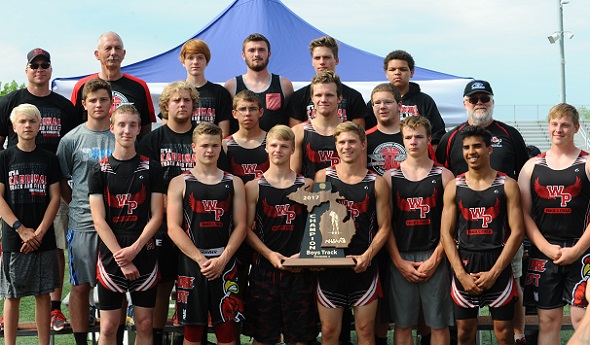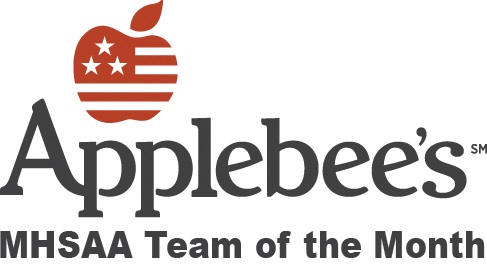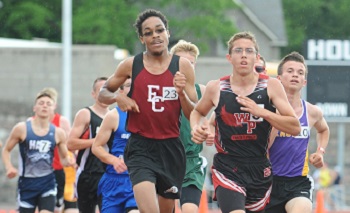
Cardinals Cap Unbeaten Season with 1st Title
June 12, 2017
By Geoff Kimmerly
Second Half editor
As coach Jeff Erickson searched the hallways for athletes to bolster his boys track & field team, he let them know up front this was not a sport where they’d get tons of attention and hype.
 This season, those 28 athletes instead earned an MHSAA Finals championship.
This season, those 28 athletes instead earned an MHSAA Finals championship.
With a few football players here, some basketball players there, and a boost from the cross country program started only four years ago, Whittemore-Prescott routed its Lower Peninsula Division 4 Regional opponents by 98 points and then claimed the Michigan Interscholastic Track Coaches Association Division 4 team championship over Memorial Day weekend.
Technically, those accomplishments earned the Cardinals the MHSAA/Applebee’s Team of the Month award for May. But it’s impossible to not also mention what Whittemore-Prescott accomplished the following weekend, on June 3 – the Cardinals won their first MHSAA Finals boys track & field title, by five points over Manton, and without an individual event champion.
“For a Division 4 school to be as deep as we were, we had kids come out this year that really helped us out and added to our depth,” Erickson said. “We had the banquet (last week), and I told the kids the difference between us and everybody else was our number two and number three (in each event). Everybody is going to have one or two good kids, and sometimes that’s enough to win a state meet … but we had our share of really good kids, and our key was our number two and number three.”
Whittemore-Prescott won every meet it participated in this season.
The 187 points scored at the Regional not only led to the large margin of victory, but were the most scored by a boys team at any Regional this spring. The Cardinals then won the MITCA team meet by 202 points with first place finishes in four events: junior Michael Eagen in long jump, junior Zane Aldrich in the 1,600 and by the 400 and 800 relays.
The MHSAA Finals are scored a little differently than MITCA’s team meet, taking more into account a team’s elite performances – but the Cardinals’ depth still showed through.
Although there were no individual winners, Eagen was second in the long jump, a half-inch out of first. Senior Azaiyah Bell took fifth in the 100 meters, and junior Bradley Lomason was sixth in the 400. Senior Hunter Kensa was seventh in the 800, and Aldrich was fourth in the 3,200. The 1,600 relay of senior Ian Driscoll, Bell, sophomore Ridge Schutte and Lomason took second, only a half-second back, and after the same group placed third in the 800 relay.
“I thought we had a chance to be very, very good, but believe it or not we lost a lot from last year,” said Erickson, referring to his team that finished sixth in LP Division 4 in 2016. “But teams lose kids every year. It’s really about trying to fill those voids and seeing into the future. We go after the (MITCA) team meet, because to be in the position (to win) you have to have three pole vaulters, three hurdlers, and that’s helped us to have that depth. We always try to have a back-up plan.”
 Erickson, a 1989 graduate of the school, also had an advance plan to build up the program – although all of the pieces fell into place perhaps more smoothly than could have been imagined and with a few beneficial surprises along the way.
Erickson, a 1989 graduate of the school, also had an advance plan to build up the program – although all of the pieces fell into place perhaps more smoothly than could have been imagined and with a few beneficial surprises along the way.
Groundwork was laid when Erickson started an offseason “Iron Club” for athletes from any program – for example, the softball team has been one of the biggest participants as Cardinals from all sports take advantage of another chance to put in extra work. Among those Erickson recalled recruiting to the Iron Club was now-senior Nick Stern, who won Regional titles this season in both the discus and shot put.
Another significant piece was the formation of the cross country program in 2013. Erickson, then the athletic director and track & field coach, was approached by then-sophomore Clayton Lange about starting the team. Erickson told Lange he’d do so and coach if Lange could find six classmates to fill out the roster with him – and when Lange did, Erickson and assistant Leroy Oliver got that program rolling.
In addition to Oliver, Erickson found more valuable help. Al Kushion joined his track & field staff after 31 years coaching at McBain. Doug Grezeszak, a MITCA Hall of Fame coach at Ogemaw Heights and Whittemore-Prescott alum, also came on to assist. Tim and Jody Yorton joined to instruct the throwers; Jody had been an All-American at Ferris State.
And Erickson’s contributions can’t be overstated. He originally took over the program on short notice while serving as athletic director in 2007 when his coach at the time was called into active military duty. Add in his roles in the formation of the cross country program and as a recruiter in the halls both for his team and the Iron Club. And then consider that this was his first school year not at the school – he moved on before last fall to the Clare-Gladwin Regional Education Service District, about an hour drive from Whittemore-Prescott.
That daily trip meant relying more on his assistants. It also meant pushing Iron Club later into the afternoon, which meant athletes often went home and came back to work out – and Erickson said this team was especially committed to doing so.
“It was kind of a unique story from the perspective of that, and the kids and what they were able to do,” Erickson said. “What the kids were able to accomplish, it was such a great thing.”
Past Teams of the Month, 2016-17
April: Frankfort baseball - Report
March: Flushing girls basketball - Report
February: Grand Rapids Forest Hills Central girls skiing - Report
January: Powers North Central boys basketball - Report
December: Dundee boys basketball - Report
November: Rockford girls swimming & diving - Report
October: Rochester girls golf - Report
September: Breckenridge football - Report
PHOTOS: (Top) Whittemore-Prescott’s boys track & field team stands together with its first MHSAA Finals trophy in the sport. (Middle) The Cardinals’ Zane Aldrich leads the pack during the 3,200 at the Lower Peninsula Division 4 Finals at Grand Rapids Houseman Field. (Photos by Dave McCauley/RunMichigan.com.)

Hastings Relays Reigns as State's Oldest Continuous Track & Field Meet
By
Steve Vedder
Special for MHSAA.com
April 10, 2024
Bob Branch remembers dabbling in other sports, but his first love was always running.
 The Hastings High School graduate admits he could never hit a baseball, football didn't especially appeal to him and basketball was just another way to spend time with friends. But for Branch, now 93, there was always track. That's the sport where his fondest and sharpest memories remain. And if you're talking track, many of his favorite memories come from participation in the state's oldest continuous track meet, the Hastings Relays.
The Hastings High School graduate admits he could never hit a baseball, football didn't especially appeal to him and basketball was just another way to spend time with friends. But for Branch, now 93, there was always track. That's the sport where his fondest and sharpest memories remain. And if you're talking track, many of his favorite memories come from participation in the state's oldest continuous track meet, the Hastings Relays.
Always held in early April, the meet dates back to 1937 – a bygone time that saw the first hostilities of World War II, gas at 20 cents a gallon and a loaf of bread selling for a dime.
And at a dusty old track surrounding the county fairgrounds in Hastings, a small relay event that included a scattering of participants from a dozen high schools was taking its first tentative steps.
Branch recalls a time when kids would run home after track practice because there were no buses, inexperienced young coaches had little actual knowledge of running fundamentals, and athletes looked at the sport as an afterthought after spending most of their high school days playing football and basketball.
 For Branch, the relays were the ideal way to ease into the track season.
For Branch, the relays were the ideal way to ease into the track season.
"I just liked to run," said Branch. "I remember I anchored a relay with my brother, and it always seemed cold when we had that meet. I remember teams would come from all over and you saw a lot of good athletes. Everybody seemed to have someone who was really good. Track wasn't very popular at that time, but I have a lot of good memories from running."
The Hastings Relays, which has changed formats and even names during its nearly nine-decade history, would traditionally kick off the track season. The meet was originally held at a makeshift quarter-mile track which surrounded the town's fairgrounds and was part of the city's annual Hastings Carnival – the track would become the midway during fair time.
The meet eventually moved to Johnson Field when the football field was dedicated in 1949 and ballooned to as many as 50 teams at its peak in 1957. For more than seven decades it was known as the Hastings Relays and then the Hastings Co-Ed relays before becoming the current Hastings Invitational, with the latest edition scheduled for Friday.
Johnson Field had a cinder track before it became an all-weather surface in the 1980s. During a time long before computers would be used to organize meet heats in mere minutes, Hastings coaches of all sports – defined as "volunteers" by the athletic department – would meet on the Friday before competition to hash out events.
People associated with the meet still recall the camaraderie built on those long Friday nights, followed by working what would often become 10-hour meets. Steve Hoke has been involved since watching his father, Jack, who coached teams at 15 of the meets beginning in 1951 and also had run in the first Hastings Relays. Steve Hoke later competed in the Relays as well during the early 1970s before becoming an assistant track coach, later the Hastings athletic director and now a volunteer worker.
"It was always a huge deal," said Hoke, who said the meet began as a pure relay event before transitioning to its current team format in the 1990s. "I remember we'd line the track the night before, and all the coaches would come to the house to organize everything. There was a brotherhood.”
 If you quiz many of the fleet of volunteers who've worked the relays over the years, each has a different memory from the meet. While Hoke describes the brotherhood and Branch the outstanding competition, others remember weather and the time a thunderstorm wiped out the line markings on the cinder track, or waking up to find three inches of snow that caused a rare cancellation of the meet. Others recall the shock of moving from the cinder to all-weather track or using the meet as an early measuring stick of what it would take to qualify for the state meet. The real old-timers remember the meet disappearing for three years during World War II.
If you quiz many of the fleet of volunteers who've worked the relays over the years, each has a different memory from the meet. While Hoke describes the brotherhood and Branch the outstanding competition, others remember weather and the time a thunderstorm wiped out the line markings on the cinder track, or waking up to find three inches of snow that caused a rare cancellation of the meet. Others recall the shock of moving from the cinder to all-weather track or using the meet as an early measuring stick of what it would take to qualify for the state meet. The real old-timers remember the meet disappearing for three years during World War II.
Hastings native and Western Michigan grad Tom Duits was the state’s first collegian to break the four-minute mile when he ran a 3:59.2 at a meet in Philadelphia in 1978. Duits, who ran in three Hastings Relays, was in line to join the U.S. Olympic team in 1980 before the United States pulled out of the games due to tension with Russia.
Duits has his own memories of the meet and the competition he faced there.
"I remember sunshine and being excited to be competing again. There were all these athletes swarming around; it was an awesome display of talent," he said. "It was always one of the best meets we'd be in. You could pretty much see the level of runners who would be at state, which made it a big deal. It was always early, but you could tell where you stood. It was great exposure."
Hastings track star Wayne Oom competed in four Hastings Relays from 1984-87. One of his sharpest memories was the difference between running on a raw cinder track versus the far more comfortable all-weather surface.
"Those cinders would grind into your skin," said Oom, part of the Hastings school record in the two-mile relay. "But I think it helped us because when we'd go to other tracks, it seemed we would run faster. I remember how competitive it was, especially in the distances. There were some great runners."
While participants have their unique memories, so do coaches. Former Saxons coach Paul Fulmer remembers 2008 when his team finished first on the boys side of the meet while his wife, Grand Haven coach Katie Kowalczyk-Fulmer, saw her girls team win the championship.
 "I knew we were one of the favorites to win because we were usually near the top of our conference and Regional," he said. "But then Katie's team was pretty good, and it was cool for them to win too."
"I knew we were one of the favorites to win because we were usually near the top of our conference and Regional," he said. "But then Katie's team was pretty good, and it was cool for them to win too."
Fulmer, who coached Hastings from 1978-81 and then 1985-2010, said at least part of the meet's popularity was derived from a unique way of scoring. Instead of individuals earning points solo, participants worked in pairs. For instance, two athletes would combine their shot put or long jump scores. New events such as the 1,500 relay and sprint medley were added.
"We had a tradition of being the state's oldest meet, and that was a big deal," Fulmer said. "And we ran a good relay; that attracted teams too. We took a lot of pride in that.
"And we'd get quite a lot of people to come to the meet. We'd set up until like 9 or 10 p.m., and then we'd have a party with all the coaches on Friday night."
While the meet has stretched 87 years, Branch said early participants and current runners have one thing in common: a drive to win. Branch ran in an era when the popularity of high school track was in its infancy. Today some of the best all-around athletes at a school are involved in the track program. The relays span the nearly nine decades in between.
"The quality of teams has gotten better and better," said Branch, the 1947 Lower Peninsula Class B Finals champ in the 220. "And this has made for a better meet. We would get guys who played football or baseball kind of drift into track, and that made the sport better. I think people began to appreciate track because we'd get teams from all over.
"We went from not really knowing what we were doing to track being a good sport. Even then, I'm not sure we appreciated what we had. We really liked the Hastings Relays and always wanted to do well there. It became popular and quite an honor to do well. Those are the kind of things I remember."
PHOTOS (Top) Racers run at the Hastings Relays, with several more awaiting their turns to compete at the longtime meet. (2) The author wrote on the 50th anniversary of the Relays for the Hastings Banner nearly 40 years ago. (3) Past athlete, coach and athletic director Steve Hoke shows some of the Relays awards from the 1930s. (4) Tom Duits was one of the state’s biggest track stars of the 1970s and ran in three Hastings Relays. (Top photo by Dan Goggins, Hoke photo provided by Steve Hoke and Duits photos provided by Tom Duits.)

